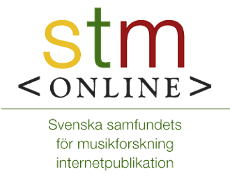Welcome to Volume 14 (2011)
of STM-Online
The articles collected here represent three different areas of music research: cultural studies, ethnomusicology, and history. They have a common feature in displaying Sweden as part of an international context, though admittedly in rather different ways. An important trait is the use of visual and auditory elements. Art works or visual documents play a role in all three articles, though it is the use of video-clips that make the publication on Internet not just elegant, but even congenial.
The interrelation between music and landscape has been an important topic in recent music research, e.g. regarding works of Elgar, Grieg, and Sibelius. Taking her point of departure in the landscape as a cultural image, Annika Lindskog (now lecturer at University College London) investigates the relation between the Swedish composer Wilhelm Peterson-Berger's Third Symphony Same-ätnam and notions of Lapland and its nature.
The fate of musical practices in changing contexts is a vital field of research for modern ethnomusicology, not just reflecting realities but also current ideals of research. In the early 1990s, the German ethnomusicologist Andreas Meyer had been captivated by a recording of music from the Lesser Antilles, edited by his Swedish colleague Krister Malm. It took Meyer to Trinidad, where he studied Tambrin music and the new circumstances under which it is performed. Instead of its traditional contexts, weddings and other celebrations, the music nowadays is performed at political events, festivals, and concerts for tourists.
In many respects, the Northern countries belong to a periphery, with relatively late developments of different aspects of a common European culture. These developments have been multifaceted, with no simple common agenda across the countries. The Finnish musicologist Ulla-Britta Broman-Kananen compares different productions of Donizetti's Lucia di Lammermoor in the 1870s, one in Sweden by the Royal Swedish Opera and one in Finland by the Finnish Opera Company, hereby shedding light on how different European traditions influenced the actual productions and made them differ. Attending to Ida Basilier and Emmy Achté, both making their debut in the title role, the author discusses how culture spread in the two Nordic countries, as well as the importance of opera in the building of a sense of a national Finnish identity.
With this year's issue, the former editor Per F. Broman has passed on the editorship to the new team. We thank him for his excellent work, having established the e-journal as an important forum, not only for Swedish music research, but also in a much wider context.
Deadline for submitting articles for Volume 15 (2012) is April 15, 2012.
Jacob Derkert and Erik Wallrup, editors
